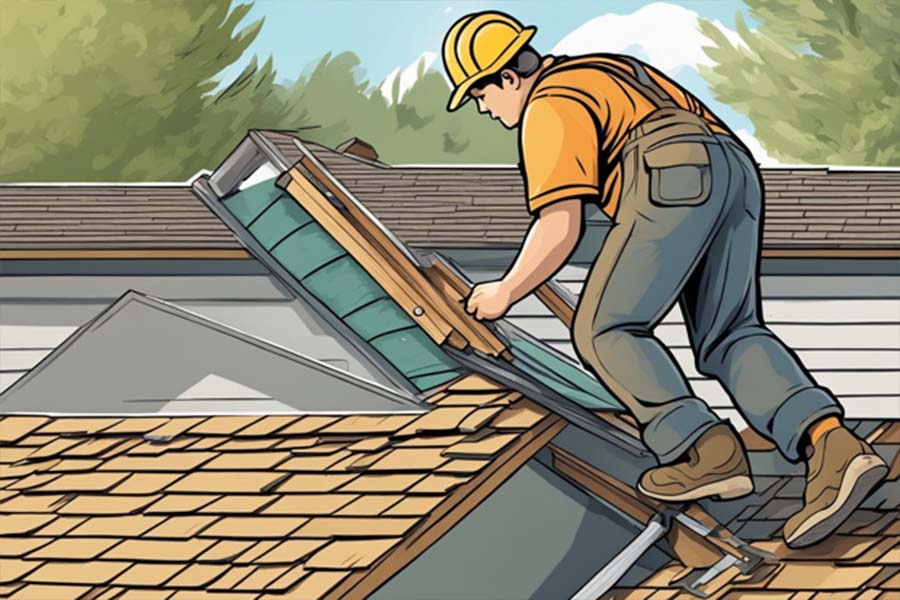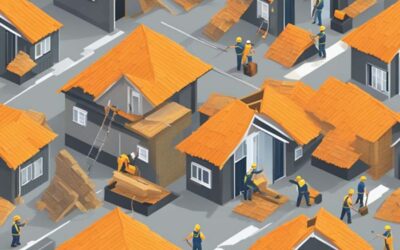DIY (Do-It-Yourself) home repairs have become increasingly popular in recent years, with many homeowners opting to tackle projects themselves rather than paying for professional services. While DIY repairs can save money and provide a sense of accomplishment, they can also lead to costly mistakes and safety hazards. This is especially true when it comes to roof repairs, which require a certain level of expertise and safety precautions.
Attempting to repair a roof without the proper knowledge and equipment can result in a range of issues, from minor leaks to major structural damage. In some cases, DIY repairs can even void a home’s warranty or insurance coverage. Therefore, it is important for homeowners to understand the potential pitfalls of DIY roof repairs and how to avoid them. By taking the necessary precautions and seeking professional help when needed, homeowners can ensure that their roofs are properly maintained and repaired.
Understanding Roof Repair
Common Roofing Problems
Roofs are an essential part of any building, and they are exposed to various weather elements, such as rain, snow, wind, and sunlight. Over time, roofs can develop several problems, such as leaks, punctures, cracks, and missing shingles. These issues can lead to water damage, mold growth, and structural damage if left unaddressed.
DIY vs. Professional Roofing
When it comes to roof repairs, homeowners often face the dilemma of whether to do it themselves or hire a professional. While DIY repairs may seem like a cost-effective option, they can lead to more significant expenses in the long run if not done correctly. Professional roofing contractors have the expertise, tools, and safety equipment required to identify and fix roofing problems efficiently and effectively. They also offer warranties that cover their work, giving homeowners peace of mind.
Safety Concerns in Roof Repairs
Roof repairs can be dangerous, especially for inexperienced homeowners. Falls from roofs are one of the leading causes of construction-related injuries and fatalities. Homeowners should take necessary precautions, such as using safety harnesses, ladders, and non-slip shoes, when working on their roofs. It is also essential to avoid working on roofs during adverse weather conditions, such as rain, snow, or high winds.
In summary, understanding common roofing problems, the pros and cons of DIY vs. professional roofing, and safety concerns in roof repairs can help homeowners make informed decisions when it comes to maintaining their roofs.
Tools and Materials
Essential Roofing Tools
When it comes to DIY roof repairs, having the right tools is essential. Without the proper equipment, you may end up causing more harm than good. Here are some of the essential roofing tools that you will need:
- Safety harness and rope
- Roofing ladder
- Roofing hammer
- Roofing nail gun
- Roofing knife
- Pry bar
- Roofing cement
- Roofing sealant
- Roofing screws
- Roofing tape
It is important to note that some of these tools require specialized training and experience to use safely and effectively. If you are unsure about how to use any of these tools, it is best to consult with a professional roofing contractor.
Selecting Quality Materials
In addition to having the right tools, selecting quality materials is also crucial for a successful DIY roof repair. Here are some tips for selecting quality roofing materials:
- Choose materials that are appropriate for your climate and weather conditions.
- Look for materials that are durable and long-lasting.
- Select materials that are easy to install and maintain.
- Check for any warranties or guarantees offered by the manufacturer.
It is important to remember that the quality of your roofing materials will directly impact the effectiveness and longevity of your DIY roof repair. Don’t skimp on quality to save a few dollars in the short term. Investing in quality materials will save you time and money in the long run.
Preparation for DIY Roof Repair
Assessing the Damage
Before starting any DIY roof repair, it is essential to assess the damage thoroughly. This assessment will help you determine the extent of the damage and the necessary repairs. You should inspect the roof for any signs of damage, such as missing or broken shingles, cracks, leaks, or holes. It is also crucial to check for any signs of water damage, such as mold or mildew growth, as this may indicate a more severe problem.
Planning and Documentation
Once you have assessed the damage, you should create a plan for the repairs. This plan should include a list of materials needed, the estimated time required for the repairs, and the steps involved in the repair process. It is also essential to document the damage and the repairs, including before and after photos, to keep track of the progress and ensure that the repairs are done correctly.
To ensure that the repair process goes smoothly, it is crucial to have all the necessary tools and materials on hand. This includes safety equipment, such as gloves and safety glasses, as well as roofing materials, such as shingles, flashing, and sealant. It is also essential to have the right tools, such as a hammer, nails, a saw, and a ladder, to complete the repairs safely and efficiently.
In summary, proper preparation is crucial for any DIY roof repair project. By assessing the damage thoroughly, creating a plan, and having the necessary tools and materials on hand, you can avoid common pitfalls and ensure that the repairs are done correctly.
Executing the Repair
Step-by-Step Repair Process
When it comes to executing a DIY roof repair, it’s important to follow a step-by-step process to ensure the repair is done correctly. Here are the general steps to follow:
- Identify the problem area: Before beginning any repair work, it’s important to identify the problem area. This can be done by inspecting the roof for any visible damage or leaks.
- Gather necessary tools and materials: Once the problem area has been identified, gather all the necessary tools and materials needed for the repair. These may include roofing cement, roofing nails, a hammer, a putty knife, and roofing shingles.
- Remove damaged shingles: Using a putty knife, carefully remove any damaged shingles from the roof. Be sure to remove all the nails holding the damaged shingles in place.
- Apply roofing cement: Apply roofing cement to the exposed area where the shingles were removed. This will help to seal the area and prevent any leaks from occurring.
- Install new shingles: Once the roofing cement has been applied, install new shingles in the area where the damaged shingles were removed. Be sure to nail the shingles securely in place.
- Seal the repair: Finally, apply a layer of roofing cement over the new shingles to seal the repair and ensure that no water can penetrate the area.
Troubleshooting Common Issues
Even when following the step-by-step repair process, there may be some common issues that arise during a DIY roof repair. Here are some troubleshooting tips to help you avoid these pitfalls:
- Uneven shingles: If the new shingles are not laying flat on the roof, use a hammer to gently tap them into place.
- Leaks: If there are still leaks in the roof after the repair has been completed, it may be necessary to apply an additional layer of roofing cement or to replace more shingles.
- Improperly installed shingles: If the shingles are not installed correctly, they may not provide adequate protection against the elements. Be sure to follow the manufacturer’s instructions carefully when installing new shingles.
By following these step-by-step instructions and troubleshooting tips, you can successfully execute a DIY roof repair and avoid common pitfalls.
Post-Repair Considerations
Inspecting the Repair Work
After completing a DIY roof repair, it is important to inspect the work to ensure that it was done correctly and that there are no lingering issues. The first step is to visually inspect the repaired area, looking for any signs of damage or wear and tear. It is also important to check for any leaks or water damage that may have occurred during the repair process.
If the repair work was done correctly, there should be no visible signs of damage or leaks. However, if there are any issues, it is important to address them immediately to prevent further damage to the roof or the interior of the home.
Long-Term Roof Maintenance
Proper maintenance is essential to ensure the longevity of a roof. After completing a DIY repair, it is important to continue to maintain the roof to prevent future damage. This includes regular inspections, cleaning gutters and downspouts, and trimming trees that may be too close to the roof.
It is also important to keep an eye out for any signs of damage, such as missing or damaged shingles, and to address them promptly. Regular maintenance can help prevent costly repairs in the future and extend the life of the roof.
In conclusion, while DIY roof repairs can save money in the short term, it is important to take post-repair considerations seriously to ensure that the repair work was done correctly and to prevent future damage. Regular maintenance is key to ensuring the longevity of a roof and preventing costly repairs.





0 Comments